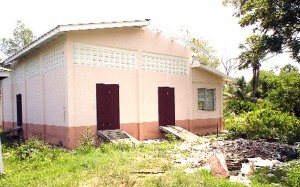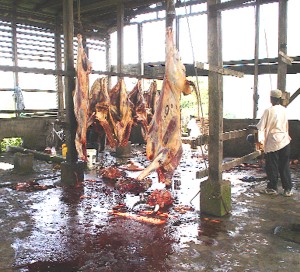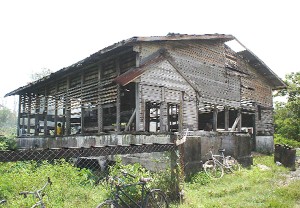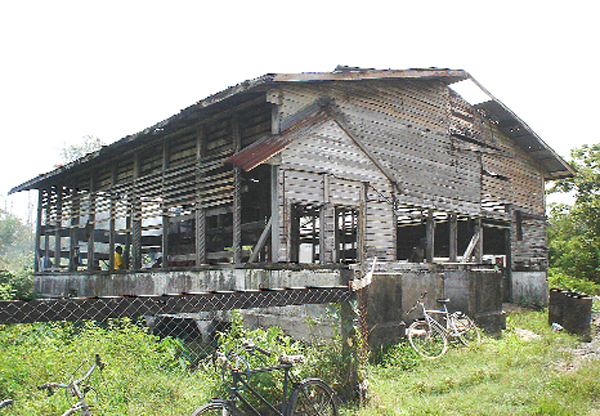By Keisha Mc Cammon
Nearly two years after a new $19.1 million abattoir was commissioned in New Amsterdam the building has been vandalised and remains unused because workers refuse to move into it on the grounds that it is unsafe to conduct slaughters there.
The old, dilapidated structure, which is next to the new building, is still being used by slaughterers.
 Meanwhile the new abattoir remains closed and has been targeted by thieves who have removed several zinc sheets from the roof, among other things.
Meanwhile the new abattoir remains closed and has been targeted by thieves who have removed several zinc sheets from the roof, among other things.
Town Clerk Cheryl John when contacted about the situation stated that the council was aware of the issues and would be addressing them when they receive the expected $10 million government subvention later this year.
On a recent visit to the abattoir, workers who declined to give their names stated that they would not move over to the new building until their safety concerns were addressed. They said that to use a building that was unsuitable for slaughtering animals would be putting their lives at risk.
The new abattoir built by the government, they explained, was too small and the ramp that the animals had to walk up was too narrow. Additionally the workers said that the restraints that had been installed to hold the animals were inadequate, and it would be easy for them to break loose and attack the men.
 Also, if the tiles were wet there was a possibility they could slide and injure themselves and lose control of the animals, which could prove fatal.
Also, if the tiles were wet there was a possibility they could slide and injure themselves and lose control of the animals, which could prove fatal.
When this newspaper visited the old, run-down abattoir, pieces of meat could be seen hanging on hooks, cow heads and cow heels were on the floor and a large pot was boiling in the corner with what was said to be cow heel.
According to the employees, given that the new facility lacked the basic equipment needed for slaughter, they preferred to work in the old facility, despite the fact that it had no doors, leaked when it rained, had missing boards and lacked lights. They said they were forced to stop work every time it rained because of the leaking roof, and in addition, water had to be brought in drums to clean the animals and the working area after use.
However, apart from the features which allowed the men to work in greater safety than in the new abattoir, the old shell, they told this newspaper, had the advantage of being much larger than the new structure, with more ventilation.
 The workers said that they had been promised improvements but to date nothing had been done.
The workers said that they had been promised improvements but to date nothing had been done.
Some said that the new building was fancy but not functional. They joked that it was probably built for the purpose of killing chickens and other poultry, and goats.
The workers also complained about the lack of security in the area which was causing thieves to remove parts from the new building undeterred. Already persons unknown had taken several zinc sheets from the roof, and removed louvre window panes and the building’s guttering.
The Town Clerk confirmed that the workers had complained about the new abattoir and had refused to move over because they feared for their safety. John said the new building had problems such as no electricity and that the workers had pointed out that the ramp was too steep and could crack under the weight of the animals, even demonstrating to the council its ineffectiveness. She also said there was only one hoist while a pair was required.
Speaking about the vandalising of the new building she said that at one time the area had had security but they had complained after seeing armed persons in the area which is unlighted and bushy and was close to the river. She stated that with the subvention, the council would look at having electricity in the area as well as security.
Animals such as cows and pigs are slaughtered at the old abattoir every Monday, Wednesday and Friday and transported to the New Amsterdam market for sale. As many as seven cows are slaughtered on a busy day, but on other days four are slaughtered. A cleaner usually cleans up after the slaughterers leave and removes the waste with a tractor.
After years of campaigning, the new abattoir was commissioned in October 2006. It cost $19.1 million. It was built next to the old one in Queenstown after an earlier attempt at constructing one close to Esplanade Road was abandoned when persons complained about the location.










